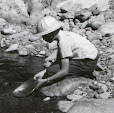Saturday, April 9, 2016
How to Display Sections and Townships in Google Earth
(Note: This article updates a previous post and replaces the link in the right-hand sidebar section that was lost when the blog was hacked a few years ago.)
----------------------------------------------------------------------------------
If you're conducting research on areas to prospect or working up the legal description for filing a mining claim, one of the things you need to know is where the parcel in question lies with respect to the Public Land Survey System (PLSS).
The PLSS is the easiest way to describe the location of your claim when making out a Notice of Location. It is also the system used by the Bureau of Land Management (BLM) Master Title Plats that tell you which areas are open to Mineral Entry, meaning, where you are allowed to stake a claim.
This blog has previously discussed some of the ways to use Google Earth as a prospecting aid. (See Armchair Prospecting with Google Earth and More on Armchair Prospecting.)
The PLSS is available as a convenient overlay on Google Earth.
If you don't already have this handy program, I suggest you download the Google Earth Pro (GEP) version as it is now free. (It previously cost $399 per year.) Here is the link:
http://www.google.com/earth/download/gep/agree.html
Be sure to read the system requirements and the note regarding the free license.
Once GEP is installed and running, navigate to PLSS in Google Earth and click on the "download GLSGE" link in the box near the top of the page. Doing this will download a file named "plss.kml" which you can open in Google Earth by clicking on File>Open in the GEP menu bar and navigating to where you saved the file (generally the "Downloads" folder).
In "Temporary Places" in the GEP left-hand sidebar, you will find entries for the PLSS overlay application. Be sure the radio button next to "Automatic" is checked under the "Refresh Mode" section. To show Sections and Townships, check the radio button next to "Townships" in the "Overlays" section.
You should then see Section and Township borders and labels on your GEP display. (You may have to zoom in some before they show up.)
The borders and labels will refresh about two seconds each time after you stop moving the map. As you might find this behavior somewhat annoying, you can switch auto-refresh off by checking the radio button next to "Manual" in the "Refresh Mode" section mentioned earlier. To return to auto-refresh, just check the "Automatic" radio button again.
Note that sometimes there is a slight difference between where the Section and Township borders appear in GEP and where they actually are. This means before you do anything important like filing a mining claim, be sure to double-check the border locations with an actual map. For comparison purposes, below is part of the USGS 7.5 minute quadrangle map of the same area around Blewett, Washington shown in the picture at the top of this article.
When you close GEP, it will ask you if you want to save the locations in your "Temporary Places" folder. If you click "Yes," the PLSS overlay application will load automatically each time you start GEP. Otherwise, you can always load the file manually as you did the first time.
I hope you find both Google Earth Pro and the PLSS in Google Earth overlay useful in your prospecting endeavors.
As always, if you have any questions or observations, please enter them in the comments and I will do my best to answer promptly.
Question: Have you used Google Earth in your prospecting/mining activities and, if so, how did it work out for you? You can answer in the comments section.
Subscribe to:
Post Comments (Atom)



2 comments:
How to I find the quarter section. I have plss loaded into google earth but I cant figure out how to get the quarter section
Hi lkzahn87124,
Thanks for your comment, and for being a reader of my blog.
Unfortunately, PLSS in Google Earth only displays whole sections, and not any subdivisions thereof. Also, as noted in the article, the location of the section lines on the ground is only approximate, and therefore should not be relied on in any legal context.
Having said all that, my method for displaying quarter sections is to locate the mid-points of each of the four sides of the section in question, and then to draw a straight line connecting the midpoints of each pair of opposite sides. Doing this will show you approximately where the quarter sections lie. If you need more precision than this, do the same process with a USGS 1:24000 scale quadrangle map that shows the section you are interested in. All USGS 1:24000 scale quadrangle maps (and many other similar maps as well) are available for free download from
https://ngmdb.usgs.gov/topoview/viewer/#4/39.64/-101.29
Instructions for using this service are on the right-hand side of the above web page.
I hope this helps answer your question.
Tom
Post a Comment